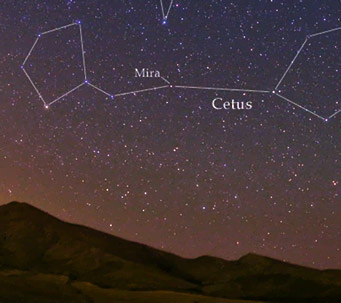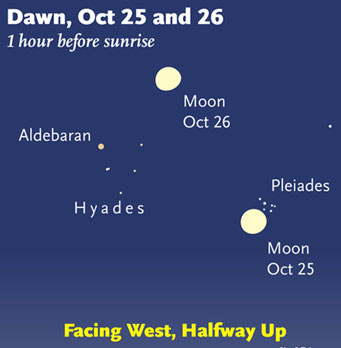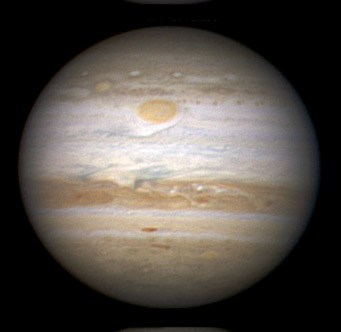Periodic Comet Hartley 2, though still nearly its closest to Earth, is pretty much lost in the moonlight this week. Moon-free observing times return around the morning of November 1st. On the morning of November 4th, NASA's EPOXI mission will fly by the comet's nucleus. See our article Comet Hartley 2 At Its Closest, with finder charts.

Now at naked-eye visibility, Mira in Cetus climbs the eastern sky in late evening — in this case, over hills in Iran.
Babak A. Tafreshi
Mira, the brightest long-period red variable star, should soon start to fade from its unusually bright maximum. As of October 19th observers were still reporting it at about magnitude 3.0, obvious to the unaided eye. Mira is up in good view in the east-southeast by about 10 p.m. daylight saving time. Use the comparison-star chart in the September Sky & Telescope, page 58.
Friday, October 22
Saturday, October 23

Catch the waning gibbous Moon passing through Taurus in early dawn. How well do you know the waning Moon in your telescope? (The Moon is shown three times actual size for clarity. Its placement with respect to the stars is exact for the middle of North America.)
Sky & Telescope diagram
Sunday, October 24
Monday, October 25
Tuesday, October 26
Wednesday, October 27
Thursday, October 28
Friday, October 29
Saturday, October 30
Want to become a better amateur astronomer? Learn your way around the constellations. They're the key to locating everything fainter and deeper to hunt with binoculars or a telescope.
For an easy-to-use constellation guide covering the whole evening sky, use the big monthly map in the center of each issue of Sky & Telescope, the essential magazine of astronomy. Or download our free Getting Started in Astronomy booklet (which only has bimonthly maps).
Sky Atlas 2000.0 (the color Deluxe Edition is shown here) plots 81,312 stars to magnitude 8.5. That includes most of the stars that you can see in a good finderscope, and typically one or two stars that will fall within a 50× telescope's field of view wherever you point. About 2,700 deep-sky objects to hunt are plotted among the stars.
Alan MacRobert
Once you get a telescope, to put it to good use you must have a detailed, large-scale sky atlas (set of charts). The standards are the Pocket Sky Atlas, which shows stars to magnitude 7.6; the larger Sky Atlas 2000.0 (stars to magnitude 8.5); and the even larger and deeper Uranometria 2000.0 (stars to magnitude 9.75). And read how to use your charts effectively.
You'll also want a good deep-sky guidebook, such as Sky Atlas 2000.0 Companion by Strong and Sinnott, or the more detailed and descriptive Night Sky Observer's Guide by Kepple and Sanner, or the classic if dated Burnham's Celestial Handbook.
Can a computerized telescope take their place? I don't think so — not for beginners, anyway, and especially not on mounts that are less than top-quality mechanically. As Terence Dickinson and Alan Dyer say in their Backyard Astronomer's Guide, "A full appreciation of the universe cannot come without developing the skills to find things in the sky and understanding how the sky works. This knowledge comes only by spending time under the stars with star maps in hand."
This Week's Planet Roundup
Mercury and Venus are hidden in the glare of the Sun.
Mars, dim at magnitude +1.4, continues to linger very low in the southwest after sunset. Use binoculars to scan for it early in twilight. Don't confuse it with twinklier Antares, which is off to Mercury's left and a trace brighter.

Jupiter on October 13th at 12:55 UT. South is up. To the upper left of the Great Red Spot is Oval BA (Red Spot Junior) with a distinct dark halo around it. The two spots continue slowly drawing apart. Note the strange, thin, wide-dipping dark plume forming what's normally the Great Red Spot Hollow, just below the spot. Also, huge disturbances are taking place in the broad, dark North Equatorial Belt and the adjacent part of the Equatorial Zone at about the same longitude as the Great Red Spot.
Don't expect an eyeball view like this in any telescope, no matter how big! Planetary imager Christopher Go continues to demonstrate the extraordinary power of stacked-video imaging done with years of experience.
Jupiter (magnitude –2.8, at the Pisces-Aquarius border) shines high in the southeast to south during evening. It's by far the brightest starlike point in the sky. In a telescope it continues to appear a big 47 or 48 arcseconds wide.
Jupiter's Great Red Spot is near System II longitude 157°. Assuming it stays there, here's a list to print out of all the Great Red Spot's predicted transit times for the rest of this observing season.
Saturn (magnitude +0.9, in Virgo) is visible low in the east in early dawn. The best time to try observing it with a telescope is in moderately bright morning twilight (perhaps an hour before your local sunrise time), when it will be less blurred by the low-altitude atmospheric mess. Saturn's rings have opened to 7° or 8° from edge-on.
Uranus (magnitude 5.7) is 3° east of Jupiter.
Neptune (magnitude 7.8, in Capricornus) is highest in the south after dinnertime. See our finder charts for Uranus and Neptune online or in the September Sky & Telescope, page 56. Can you see any color in Uranus and/or Neptune?
Pluto (magnitude 14.0, in Sagittarius) is sinking low in the southwest after dark.
All descriptions that relate to your horizon — including the words up, down, right, and left — are written for the world's mid-northern latitudes. Descriptions that also depend on longitude (mainly Moon positions) are for North America. Eastern Daylight Time (EDT) equals Universal Time (also known as UT, UTC, or GMT) minus 4 hours.
To be sure to get the current Sky at a Glance, bookmark this URL:
http://SkyandTelescope.com/observing/ataglance?1=1
If pictures fail to load, refresh the page. If they still fail to load, change the 1 at the end of the URL to any other character and try again.
 0
0
Comments
You must be logged in to post a comment.